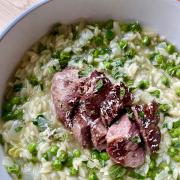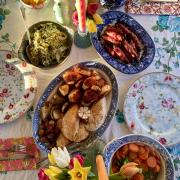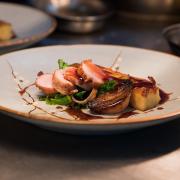When it comes to unearthing fascinating fungi, former chef Richard Sawden is the go-to expert

If you go down to the woods today you’re sure of a big surprise. Well, teddy bear’s picnics aside, head into the New Forest at this time of year and the biggest head-turner is often the explosion of wild mushrooms emerging under your feet.
From fairy tale-like red and white spotted toadstools to giant puffballs, the Forest is one of the most important sites for mushrooms in Britain with almost 3,000 different species known to grow here.
However, where foraging for wild mushrooms was once a popular pursuit in this part of the county, in order to protect the fragile ecosystem, Forestry England outlaws picking for commercial sale.
And all visitors are encouraged to ‘please look but don’t pick’ out of respect for the natural environment which relies so heavily on fungi playing its vital part within the ‘web of life’.

All of which explains why Ringwood based Richard Sawden, founder of New Forest Wild and Exotic Mushrooms, is registered to lead mushroom identification workshops on the commonland, whilst focusing his foraging on private land, with the landowner’s permission.
“There’s always something that can be found if you know where to look,” says Richard. “There may be several types of wild mushroom available to forage this autumn. We normally pick Chanterelle, and Penny Bun, which is also known as Porcini or Cep, and we’ve got Hedgehog mushrooms too, which are popular with customers.
“Normally mushrooms grow in lightly wooded, slightly shady areas. The harvest though is very dependent on the weather. If you’re looking for quality, then humid conditions with rain every two to three days, with cooler mornings and warmer afternoons is ideal. I usually try and get out in the morning to forage and incorporate these pickings into the mixed boxes that we supply to hotels and restaurants throughout the south.”
When it comes to provenance, these hand-picked mushrooms are in demand. And having previously run his own restaurant in Ringwood for almost ten years, Richard knows that discerning chefs expect “everything to be up to standard”. The New Forest Marque is another guarantee of the quality of this local produce, which also makes its way into Ooooby’s home-delivery veggie boxes.

Wild mushrooms however are only a part of his enterprise as, hidden away inside a barn, stand shipping containers, in which a spectacular cultivated forest of exotic mushrooms sprouts.
It’s a fascination that can be traced back to earlier times spent working in kitchens in the Far East, including a stint at the Shangri-La in Kuala Lumpur, where “they use a lot of mushrooms in their everyday cooking”, Richard observes.
“When I sold the restaurant, I didn’t have enough money to retire into the sun and so was looking around for something else. I was growing White and Chestnut mushrooms to start with, but found during these first three years that we were competing financially with imported produce from Holland and Poland.
“We needed to diversify and having started growing oyster mushrooms to begin with, now have about 14 different varieties of exotic mushrooms throughout the year. From start to fruiting varies according to variety but it is normally between six to seven weeks. Before lockdown [for Covid-19], we harvested around four tonnes of mushrooms a month and now we’re slowly building-up the volume again.”

From the brilliant coral coloured Pink Oyster to the intriguingly named Judas Ear and Saffron Milkcap, the food stuffs for these mushrooms are the dense blocks of pasteurised straw and hardwood, lined-up on racks. Artificial lights encourage growth, with the humidity regulated, and the temperature, oxygen and carbon dioxide levels carefully controlled. No sprays or chemicals are used at any stage during the process.
It is, he says, a largely single-handed operation with his family on hand to help out when needed. And should there be surplus supplies, Richard’s been known to concoct a tincture using dried Maitake mushrooms, among others.
However, it’s back outside in the forest, so familiar from childhood days growing-up in the area, that Richard sources perhaps the Holy Grail of fungi.
“About seven years ago I got permission to pick truffles on a private estate and every year I pay a retainer for this. Originally truffles were foraged using pigs and now you can get dogs that are trained. Because I know where they are growing, now I can automatically go back to the same place.

“After rain they will come to the surface and as an ex-chef this really excites me. It’s only the Summer Truffle I manage to get although this is still in demand. Usually, I gather truffles from the end of June until September. When it’s too dry they take a while to grow to a decent size but, hopefully, within the coming weeks we’ll have a decent aroma and a decent size truffle.”
Richard may have the pick of the highly-prized crop, but even on private land there’s competition from the resident wildlife. Squirrels and slugs drawn to the earthy flavour with a hint of hazelnut, chocolate and mushroom, often enjoy a tasty bite. And horses and cows can easily trample the fungi underfoot, as they do the wild mushrooms.
He’s every reason then, to ensure that future harvests for the business don’t stop at fungi. Already, land adjoining the barn has become home to a flock of quails with the promise of a ready supply of eggs. And whilst it’s still early days, heritage fruit trees have been planted.
Next, Richard has his sights on a poly tunnel to grow “produce that will be a little different”, by which he means something that’s likely to have a distinctly Oriental inspired flavour, in another nod to his time spent in Asia.
For now though, the main focus remains mushrooms. So when it comes to prepping them, are there any top tips?
“Keep it simple,” says Richard. “Quickly pan fry the mushrooms in a little butter and oil with a tiny amount of garlic. Add a little bit of cream or crème fraiche, then some freshly chopped parsley, and serve.”
Wild foods: what are the rules?
As in the New Forest, if there are local Bylaws relating to restrictions on picking in a specified area it’s important to find these out first before visiting somewhere new. Elsewhere, the Wildlife and Countryside Act says that foraging the 4 F’s – fruit, foliage, flora and fungus, from common land is acceptable so long as it is only for personal consumption.
And this means moderate amounts picked with respect for the trees, plants and mushrooms; the surrounding environment, including wildlife that may have a dependence on with what you are taking; and other people and their property.
It’s also illegal to uproot any plant from such places without the landowner’s permission. Common sense says, never to eat anything poisonous, and to never eat any wild food without multiple sources of positive identification.
The mystique of mushrooms
Historically, these fleshy, spore-bearing fruiting bodies have been in both culinary and medicinal use for centuries. Savoured as a delicacy by the Ancient Egyptian Pharaohs, the Greeks revered them as a source of strength, whilst the Chinese have long-regarded their health-giving properties.
Food for free this month
As days shorten and the autumn leaves bare their magnificent colours, the Woodland Trust (woodlandtrust.org.uk) suggests looking out for these nuts and berries ripening on hedgerows, whilst following its responsible foraging guidelines:
Bullace (or Wild Plum)
Beech Nuts
Hazelnuts
Rosehips
Sloes
Sweet Chestnuts
Walnuts
Don’t forget to follow us on Facebook, Twitter and Instagram
READ MORE: Find out more about Hampshire’s food and drink scene here



























